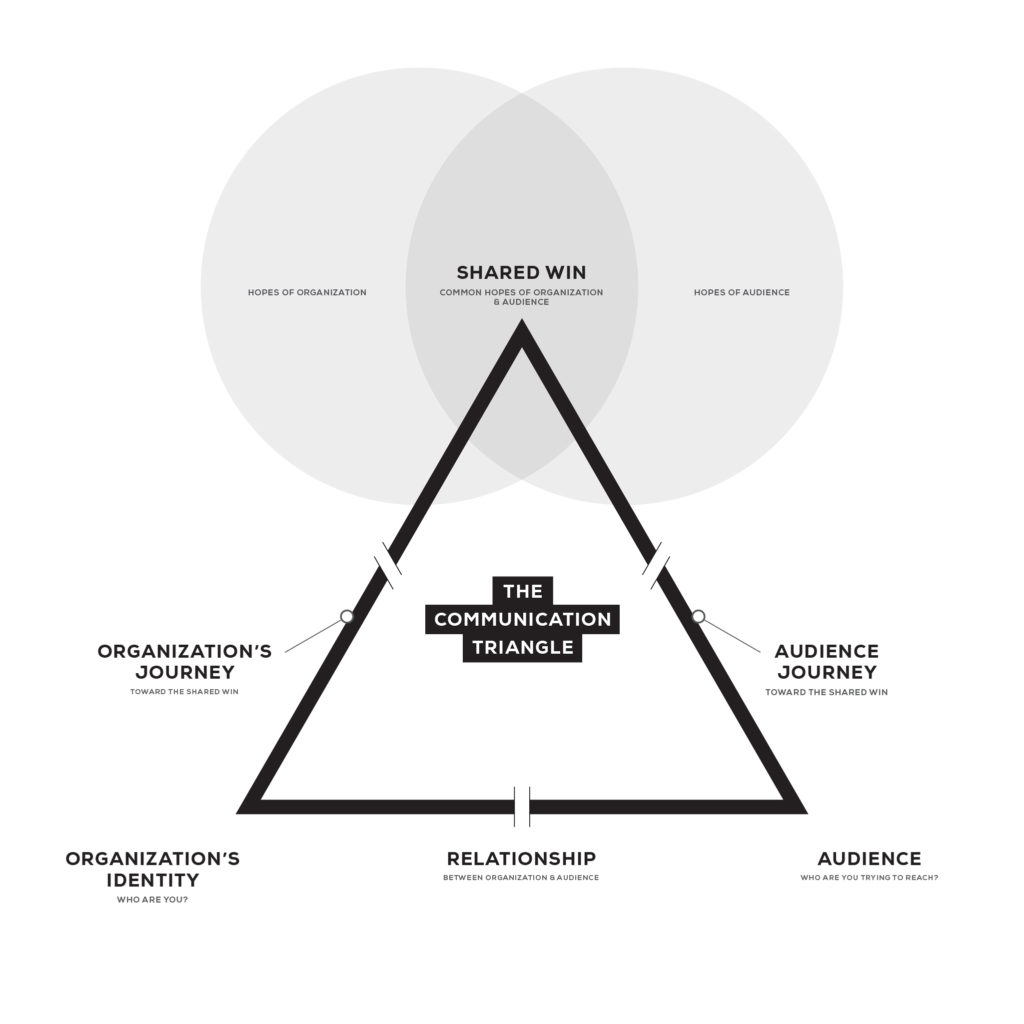We’ve had this conversation a lot.
When we first started ArtSpeak Creative, we’d get a call from a church leader. That person would often say something like, “I need a logo.”
Or, “I need a billboard design.” Or, “I need social media graphics.”
And then they’d add, “Pronto!” (Okay… we made that part up.)
We were glad to help. But after a while, we stopped ourselves from saying a simple “yes” to every request.
Instead, our answer became, Maybe.
Maybe that’s what you need. Maybe you need a logo. Maybe you need a website, a billboard, or a graphic. But marketing “tactics” do not equal a successful marketing “strategy.”
So, instead of going out and buying the next thing you think you need, stop.
Ask these five questions of yourself (and your organization) before you spend another cent on marketing.
But first…
The Communication Triangle (Again)!
When it comes to marketing, you want to eliminate as much guesswork as possible. That’s why, at ArtSpeak, we fill out a Communication Triangle before beginning any project.

That’s where you should start, too.
Just to review, the Communication Triangle is a method for organizing information. Using it, you can match what you want for your audience with what they want for themselves:
- The bottom left-hand side of the triangle represents your organization
- The bottom right-hand side of the triangle is your audience
- Between you and your audience is your reputation
- At the top of the triangle is the “shared win”
If you haven’t yet, you can download a PDF of the Communication Triangle at the bottom of this page.
These five questions will help you gather all the information you need to fill out your triangle effectively.
Question 1: Who are you?
Most people we work with have already thought about their identity quite a lot. But you’d be surprised how many organizations have never thought about some of these foundational messaging elements.
Get this all out of your head and onto a page. Start here:
- Mission statement
- Vision statement
- Core values
Next, draw out everything you can think of that’s unique about your organization.
Write down every phrase that defines what you believe, who you want to be, and your future aspirations.
Then, ask yourself:
- What’s distinctive about us?
- What are our unique advantages?
- What do we want for the future?
- How will our audience — our city, our region, or whatever— look different if we’ve accomplished what we’ve set out to do?
Write it all down. Get it all in one place. Without these pieces of the puzzle, it’s hard to know what you are inviting people to.
But too many of us stop here. We take our self-definition and put it on a web page.
No one cares! (Sorry.)
People are necessarily self-interested, but it’s not because they’re sinful. It’s because they have so many options! They have to protect themselves from the millions of voices asking for their time and attention.
So, if you want to reach them, you have to do a little more digging first.
Question 2: What Do People Think about You?
Your reputation may be standing between you and the people you want to reach. Often, you have to overcome the way people perceive you to show them who you really are … and what you can do for them.
Sometimes, it’s a positive reputation, but it doesn’t reflect where you’re headed. Other times, you have a negative reputation just because of the type of organization you are. (“Church” is a word loaded with history, both positive and negative.)
That’s okay. Answer these questions, and you’ll know what the obstacles are. What is your:
- Past reputation (if you have one)?
- Current reputation?
- Future (or aspirational) reputation?
Question 3: Who Are You Talking To?
A lot of people are reluctant to define their audience. It feels limiting.
They think, “We want to reach everybody!” And, in a way, that’s true. If you’re a ministry or a church, the message of Jesus really is for everyone. So why count people out?
Instead, think of it this way:
- Who are we called to reach primarily?
- What do we know about those people?
- Of all of the people we’re currently helping, what do they have in common?
For example, we recently led a Las Vegas-based church through their branding process. Since several of our staff members live in the St. Louis area, we started by asking, “What do people in the midwest not know about people who live in Las Vegas.”
We learned a lot! Not only did we find out that Vegas isn’t filled with leisure suits and sequins (lol), the church leaders told us:
- What the people there are like
- What variations exist inside that generalized demographic
- What hopes, fears, and challenges they have in common
People are all different, but if you can paint the very “center of the target”—the people most likely to respond to what you’re doing—you will reach people outside of that small circle.
Question 4: What Value Do You Offer?
In a coming article, we’re going to share how we create our Messaging Blueprint, one of the pillars of our branding process. The Messaging Blueprint will give you actual words to use when you address your audience.
But for now, answer these questions:
- How should people feel when they encounter our communications?
- What mediums will we use to communicate (social platforms, websites, books, kiosks, billboards, etc.)?
- What are we inviting people into?
- What value do we offer people that’s unique to us?
Now, all of the above is a good start. But it’s not enough to be “in your head” thinking all of this through. It may help to get a little outside perspective.
Question 5: Where Are Your Blindspots?
When you put all your answers to these questions in a document, you will find holes in your understanding. ArtSpeak Creative adds a few steps to this process to help you see gaps in your own experience.
First, after we read through your Discovery Questions, we get on a Zoom call with you. We talk you through all of the points above and look for more detail.
Then, we do some research. We crawl through your website and online platforms.
We look at the online presence of similar organizations reaching the same kinds of people. For most, we’ll obtain detailed demographic information. For others, we’ll conduct interviews or collect survey results.
In a few cases, we’ll come and visit you! If you’re a church, we’ll arrive on a Saturday, interview your senior leaders, then show up, unguided, on Sunday morning.
We have life-giving conversations with congregation members (we never go negative). After we get a feel for who you are, we reflect our experience back to you.
But it all starts with the Discovery Questionnaire. Have you filled one out?

